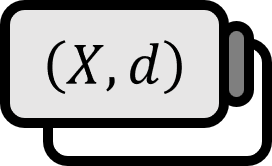Every Non-Empty Perfect Set in Euclidean Space is Uncountable
Definition
Let’s say $(X,d)$ is a metric space. Suppose $p \in X$ and $E \subset X$.
The set that includes all $q$s that satisfy $d(q,p)<r$ is defined as the neighborhood of point $p$ and denoted by $N_{r}(p)$. In this case, $r$ is called the radius of $N_{r}(p)$. It can also be denoted as $N_{p}$ when it’s okay to omit the distance.
If every neighborhood of $p$ contains a $q$ that is $q\ne p$ and $q\in E$, then $p$ is called a limit point of $E$.
If all limit points of $E$ are included in $E$, then $E$ is said to be closed.
If $E$ is closed and every point of $E$ is a limit point of $E$, then $E$ is said to be perfect.
Theorem
Suppose $P \subset \mathbb{R}^{k}$ is a non-empty perfect set. Then, $P$ is uncountable.
Proof
We prove by contradiction.
First, since $P$ has limit points, it is an infinite set. Now, assume that $P$ is countable. Then, elements of $P$ can be expressed as:
$$ \mathbf{x}_{1},\mathbf{x}_{2},\cdots,\mathbf{x}_{n},\cdots $$
Now, consider a neighborhood $N_{1}$ of some $\mathbf{x}_{1}$. Since $\mathbf{x}_{1}$ is a limit point of $P$, $N_{1}$ must contain at least one point of $P$ that is not $\mathbf{x}_{1}$. Let this point be $\mathbf{x}_{2}$. Then, we can find a neighborhood $N_{2}$ of $\mathbf{x}_{2}$ that does not include $\mathbf{x}_{1}$ by reducing the radius. By choosing a sufficiently small neighborhood, it can also satisfy $\mathbf{x}_{1}\notin \overline{N_{2}}$. Then $\overline{N_{2}}\subset N_{1}$ and $\overline{N_{2}}\cap P \ne \varnothing$. Since $\mathbf{x}_{2}$ is also a limit point of $P$, $N_{2}$ must contain at least one point of $P$ that is not $\mathbf{x}_{2}$. Let this point be $\mathbf{x}_{3}$.
In the same manner, we can find a neighborhood $N_{3}$ of $\mathbf{x}_{3}$ that does not include $\mathbf{x}_{2}$, and $\overline{N_{3}}\subset N_{2}$ and $\overline{N_{3}}\cap P \ne \varnothing$. If we continue in this way, we can select points $\mathbf{x}_{4}$, $\mathbf{x}_{5}$, $\cdots$ and their neighborhoods $N_{4},N_{5},\cdots$. Then, the set of neighborhoods $\left\{ N_{n} \right\}$ satisfies the following conditions:
(i) $\overline{N_{n+1}} \subset N_{n}$
(ii) $\mathbf{x}_{n} \notin \overline{N_{n+1}}$
(iii) $\overline{N_{n}} \cap P \ne \varnothing$
Also, $\overline{N_{n}}$ is compact since it is closed and bounded. Since $P$ is also closed, if we let $K_{n}=\overline{N_{n}}\cap P$, $K_{n}$ is compact.
Cantor’s Intersection Theorem Generalized to Metric Spaces
Let $\left\{ K_{n} \right\}$ be a sequence of compact sets that are not empty. If
$$ K_{n}\supset K_{n+1}\ (n=1,2,\cdots) $$
then $\bigcap _{i=1}^{\infty} K_{n} \ne \varnothing$
Then, $\left\{ K_{n} \right\}$, being a non-empty compact set and satisfying $K_{n}\supset K_{n+1}$, leads to $\bigcap _{n=1}^{\infty} K_{n}\ne \varnothing$ by Cantor’s intersection theorem. However, $(\mathrm{ii})$ leads to $\bigcap _{n=1}^{\infty}K_{n}=\varnothing$. This clearly contradicts, indicating the assumption was wrong. Therefore, $P$ is uncountable.
■
Corollary
All closed intervals $[a,b]$ are uncountable.
